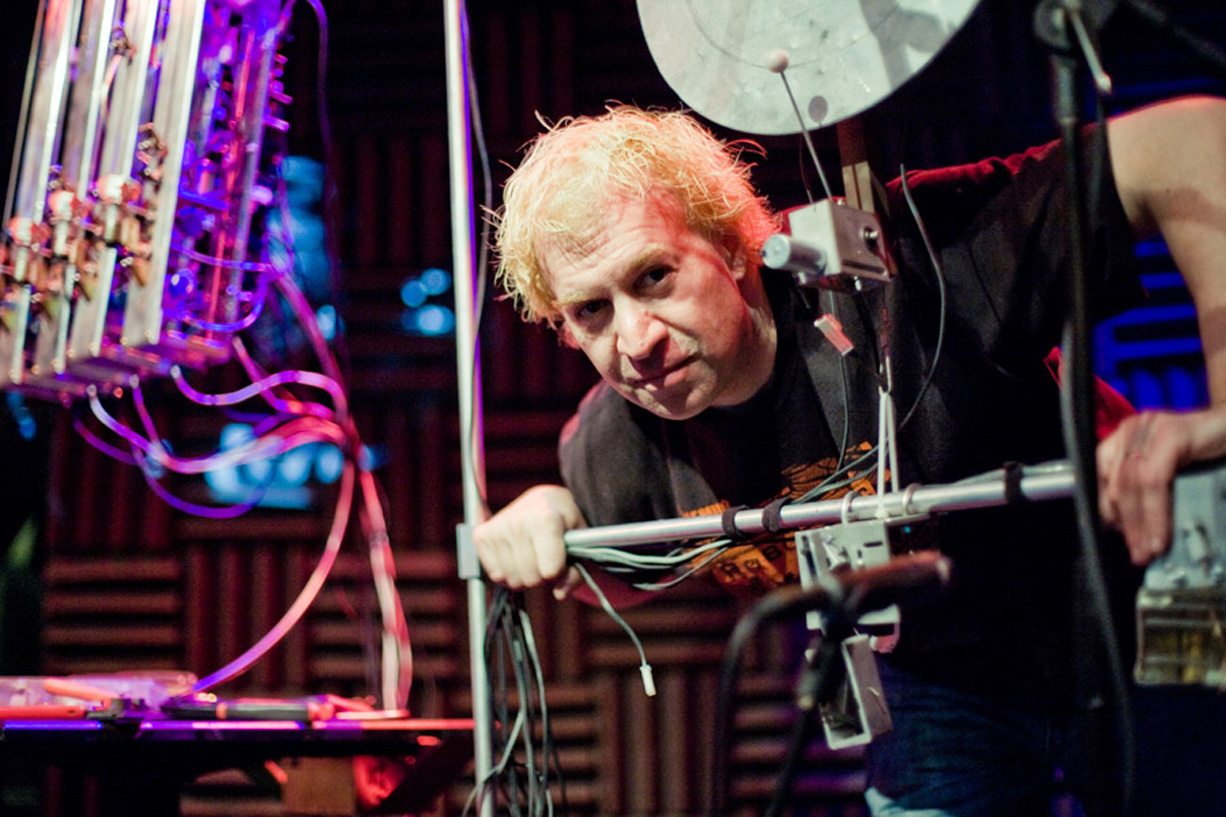Singer also took his act on the road during his first (of many) collaborations with Reynolds, a former member of Bang on a Can as well as Steve Reich and Musicians. In 2008, Reynolds toured with LEMUR and Singer through Poland, where Reynolds was so dedicated to the project that he would compose pieces throughout dress rehearsals and then play them live later the same night.
“I spend a lot of time staring at a computer screen producing and creating,” Reynolds says, “and onstage interacting with scenarios that I have set up in the laptop. My journey in the electronic music world has involved creating a hybrid, augmented instrument built out of old and new technology, so considering another set of instruments [that] were also hybrids was a no-brainer—and very compelling.”
This past May, Singer and Reynolds collaborated again for two shows, one at Joe’s Pub in New York City and another with the Albany Symphony Orchestra’s chamber group, Dogs of Desire, at the Experimental Media and Performing Arts Center in Troy, New York. “I think that his style is very well suited to work with the robots,” Singer says of Reynolds, “and he does a lot of improvisation with the robots and the instruments. That, to me, is a really good thing and a driving force for what can be done with the instruments.”
Kimura, a 2010 Guggenheim Fellowship recipient, is another musician who has taken an improvisational approach with LEMUR. She originally teamed up with Singer in 2003 while she was in New York City. After seeing a demo of his guitar bot, she knew that she had to do a duet with it. “I enjoy a certain randomization with limits so that ‘we’ can both be facing the same direction, but not necessarily taking the same road every time,” Kimura says. “[The project] certainly does have an enormous influence on my compositional process.”
A personal milestone in Singer’s career occurred in 2007, when he was able to perform with his idols They Might Be Giants and other luminaries like Subotnick, jazz trombonist George Lewis, and unclassifiable composer JG Thirlwell during Robosonic Eclectic: Live Music by Robots and Humans — a concert that included everything from laptop performances to a stringed LEMUR ensemble. “I decided to have a string quartet in my composition,” Thirlwell says of his contribution to the evening. “I enjoyed working with the guitar bot sitting right next to me, as all its mechanics are quite squeaky and percussive. I started getting used to its idiosyncrasies. It starts to feel human.”
For Singer, the concert was an opportunity to see the multitude of ways that technology could be used by musicians of completely different genres, allowing them to branch out into new creative territories. “There are always ways of simulating what real instruments sound like,” Singer says. “But the robots — I never say that they play better or worse than humans. They just play differently, so it puts a new tool into composers’ hands and is one that he or she can play with and experiment with until their heart’s content.”
Aside from its music applications, LEMUR also has lent itself to a number of art installations, including at the Children’s Museum of Pittsburgh and the Snug Harbor Cultural Center and Botanical Garden in Staten Island, New York. The LEMUR installations often take on an interactive approach and invite viewers to intermingle with the robots via video projections and motion sensors. “A typical reaction is [that] you see a projection of billiard balls on the floor, and you walk in and start kicking the balls around,” Singer says. “And every time they collide, a corresponding pair of robots play or a percussion sounds. It’s a very integrated, very interactive sound video and robotic experience and is very unique among the field.”
In addition to his work with LEMUR, Singer has delved further into algorithmic composition, which allows music to be generated by a computer based upon specific equations or set parameters. One of Singer’s projects allows a computer to take pieces written by Johann Sebastian Bach, analyze them, and reconstruct modern interpretations of Bach’s work. “I wouldn’t purport that they necessarily write anything that accurately sounds like him or is as good in his style, but they are creating something new based on a composer from the past,” he says.
Singer’s creations are an indication of the future high-tech leaps that will be made within the industry. Though his work may spark discussion about technology’s growing impact on the music, Singer considers LEMUR’s progressions to be nothing out of the ordinary.
“To me, it is just as society has done for thousands and thousands of years: create new ways to make music,” Singer says. “And musicians have generally embraced those, almost universally. With musical robots, I have had people say, ‘What’s this going to do to real musicians?’ And I say, ‘Well, I’m a real musician, and so are the people who create music for them and perform with them.’ So there you go; it’s real musicians making real music on real instruments.”

